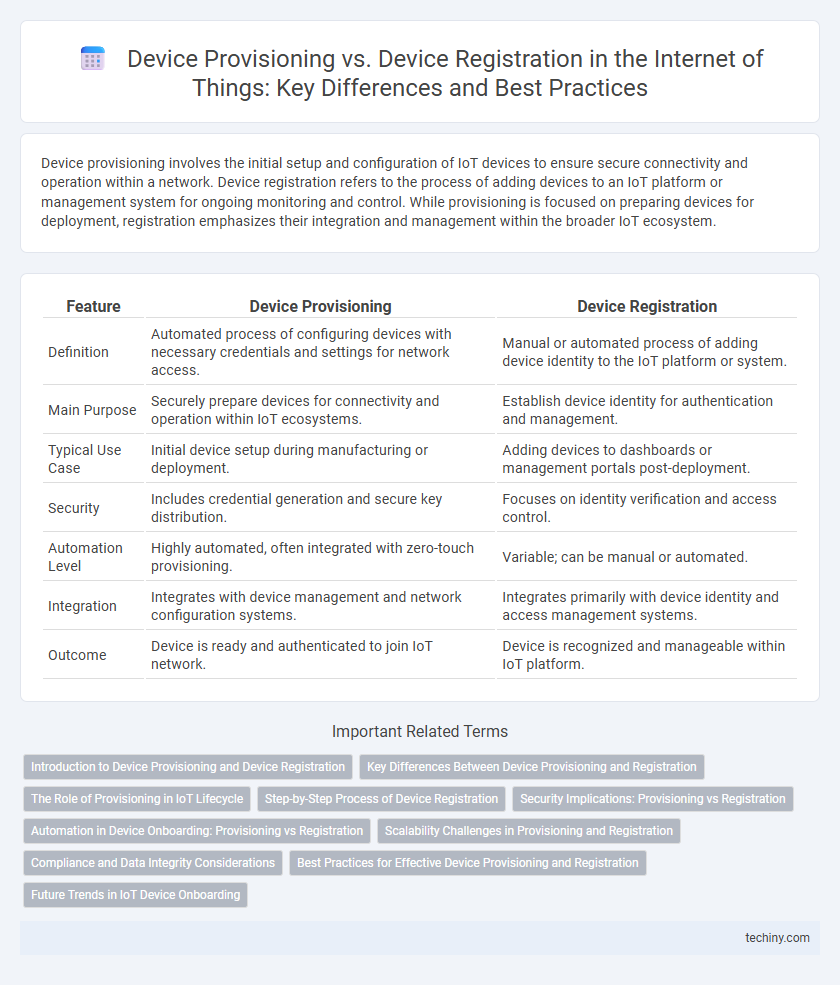Device provisioning involves the initial setup and configuration of IoT devices to ensure secure connectivity and operation within a network. Device registration refers to the process of adding devices to an IoT platform or management system for ongoing monitoring and control. While provisioning is focused on preparing devices for deployment, registration emphasizes their integration and management within the broader IoT ecosystem.
Table of Comparison
| Feature | Device Provisioning | Device Registration |
|---|---|---|
| Definition | Automated process of configuring devices with necessary credentials and settings for network access. | Manual or automated process of adding device identity to the IoT platform or system. |
| Main Purpose | Securely prepare devices for connectivity and operation within IoT ecosystems. | Establish device identity for authentication and management. |
| Typical Use Case | Initial device setup during manufacturing or deployment. | Adding devices to dashboards or management portals post-deployment. |
| Security | Includes credential generation and secure key distribution. | Focuses on identity verification and access control. |
| Automation Level | Highly automated, often integrated with zero-touch provisioning. | Variable; can be manual or automated. |
| Integration | Integrates with device management and network configuration systems. | Integrates primarily with device identity and access management systems. |
| Outcome | Device is ready and authenticated to join IoT network. | Device is recognized and manageable within IoT platform. |
Introduction to Device Provisioning and Device Registration
Device provisioning in the Internet of Things (IoT) involves the initial setup and configuration of devices, ensuring they are securely connected to the network and ready for operation. Device registration refers to the process of adding devices to an IoT platform's inventory, enabling management, monitoring, and data collection. Understanding the distinction helps optimize device lifecycle management and enhances security across IoT ecosystems.
Key Differences Between Device Provisioning and Registration
Device Provisioning in the Internet of Things (IoT) involves the initial setup and configuration of devices, including assigning security credentials and network parameters to enable secure communication. Device Registration, on the other hand, refers to the process of enrolling the device into the IoT platform or system inventory, linking the device identity to the management framework for tracking and control. Key differences include provisioning focusing on establishing a secure operational state, while registration emphasizes device recognition and management within the IoT ecosystem.
The Role of Provisioning in IoT Lifecycle
Device provisioning in the IoT lifecycle involves the secure onboarding and configuration of devices, enabling them to connect and communicate within the network. It establishes unique identities, authentication credentials, and necessary permissions to ensure devices operate safely and efficiently. Unlike device registration, which primarily records device details in a management system, provisioning actively prepares devices for integration and functional operation in IoT ecosystems.
Step-by-Step Process of Device Registration
Device registration in the Internet of Things involves securely identifying and authenticating devices to connect them to the network, ensuring unique device identities and necessary credentials are established. The step-by-step process includes obtaining device-specific information, generating authentication tokens or certificates, verifying device authenticity through secure protocols, and updating the device registry with relevant metadata for management and monitoring. This process enables seamless integration, access control, and lifecycle management in IoT ecosystems.
Security Implications: Provisioning vs Registration
Device provisioning establishes secure credentials and trust relationships through cryptographic key distribution, enabling devices to authenticate and communicate safely within the IoT ecosystem. Device registration records device identities and metadata in management systems without directly handling sensitive security credentials, primarily supporting device tracking and lifecycle management. Security implications highlight that provisioning must protect credential exchange against interception and tampering, while registration processes require robust access controls to prevent unauthorized data manipulation or device spoofing.
Automation in Device Onboarding: Provisioning vs Registration
Device provisioning automates the initial setup of IoT devices by securely configuring hardware, assigning network credentials, and generating cryptographic keys before deployment. Device registration automates the integration of these provisioned devices into management platforms and cloud services, enabling continuous monitoring and control. Combining automated provisioning and registration streamlines the entire onboarding process, reduces manual errors, and accelerates large-scale IoT deployments.
Scalability Challenges in Provisioning and Registration
Device provisioning involves the initial setup of IoT devices, including configuration and authentication, while device registration records the device identity and metadata within the network. Scalability challenges arise during provisioning due to the need for secure, automated onboarding of millions of devices simultaneously, often requiring robust infrastructure and parallel processing capabilities. Device registration faces scalability issues in maintaining real-time updates and consistent synchronization across distributed databases as device numbers surge.
Compliance and Data Integrity Considerations
Device provisioning in the Internet of Things ensures secure initial setup by embedding cryptographic credentials, which enhances compliance with security standards like ISO/IEC 27001 and GDPR. Device registration involves logging device attributes and metadata into management systems, supporting audit trails that uphold data integrity and regulatory requirements. Both processes are critical for maintaining device authenticity, preventing unauthorized access, and ensuring consistent data accuracy across IoT networks.
Best Practices for Effective Device Provisioning and Registration
Effective device provisioning in the Internet of Things involves secure authentication methods, automated configuration, and scalability to handle large volumes of devices efficiently. Device registration requires accurate metadata management, unique device identifiers, and consistent synchronization with cloud platforms for seamless integration. Implementing standardized protocols like Lightweight M2M (LwM2M) and adopting zero-touch provisioning techniques enhance operational efficiency and reduce deployment errors.
Future Trends in IoT Device Onboarding
Device provisioning in IoT involves securely configuring devices with necessary credentials and network settings before deployment, while device registration focuses on authenticating and enrolling devices into management systems. Future trends in IoT device onboarding emphasize automation, leveraging AI-driven processes for seamless provisioning and registration at scale, enhancing security with zero-touch onboarding and decentralized identity frameworks. Integration of blockchain technology is set to further bolster trust and transparency throughout the device lifecycle in large-scale IoT ecosystems.
Device Provisioning vs Device Registration Infographic

 techiny.com
techiny.com